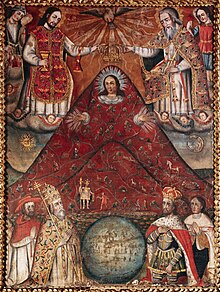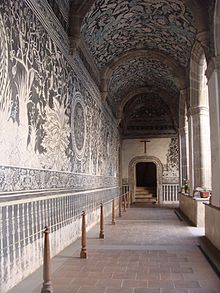
Mexican culture is primarily influenced by its Indigenous inhabitants and the culture of Spain. Mexican culture is described as the 'child' of both western and native American civilizations. Other minor influences include those from other regions of Europe, as well as Asia and Africa.

Bernardino de Sahagún, OFM was a Franciscan friar, missionary priest and pioneering ethnographer who participated in the Catholic evangelization of colonial New Spain. Born in Sahagún, Spain, in 1499, he journeyed to New Spain in 1529. He learned Nahuatl and spent more than 50 years in the study of Aztec beliefs, culture and history. Though he was primarily devoted to his missionary task, his extraordinary work documenting indigenous worldview and culture has earned him the title as “the first anthropologist." He also contributed to the description of Nahuatl, the imperial language of the Aztec Empire. He translated the Psalms, the Gospels, and a catechism into Nahuatl.

Indigenous peoples of Mexico, Native Mexicans or Mexican Native Americans, are those who are part of communities that trace their roots back to populations and communities that existed in what is now Mexico before the arrival of the Spanish people.

Juan Soriano was a Mexican artist known for his paintings, sculptures and theater work. He was a child prodigy whose career began early as did his fame with various writers authoring works about him. He exhibited in the United States and Europe as well as major venues in Mexico such as the Museo de Arte Moderno and the Palacio de Bellas Artes. His monumental sculptures can be found in various parts of Mexico and in Europe as well. Recognitions of his work include Mexico's National Art Prize, the Chevalier des Arts et Lettres and membership in France's Legion of Honour.
Latin American art is the combined artistic expression of South America, Central America, the Caribbean, and Mexico, as well as Latin Americans living in other regions.
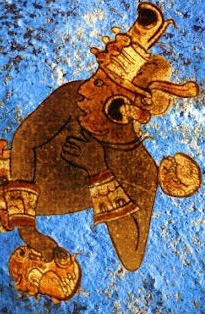
Maya blue is a unique bright azure blue pigment manufactured by cultures of pre-Columbian Mesoamerica, such as the Mayans and Aztecs.

Mexican Muralism refers to the art project initially funded by the Mexican government in the immediate wake of the Mexican Revolution (1910-1920) to depict visions of Mexico's past, present, and future, transforming the walls of many public buildings into didactic scenes designed to reshape Mexicans' understanding of the nation's history. The murals, large artworks painted onto the walls themselves had social, political, and historical messages. Beginning in the 1920s, the muralist project was headed by a group of artists known as "The Big Three" or "The Three Greats". This group was composed of Diego Rivera, José Clemente Orozco and David Alfaro Siqueiros. Although not as prominent as the Big Three, women also created murals in Mexico. From the 1920s to the 1970s, many murals with nationalistic, social and political messages were created in many public settings such as chapels, schools, government buildings, and much more. The popularity of the Mexican muralist project started a tradition which continues to this day in Mexico; a tradition that has had a significant impact in other parts of the Americas, including the United States, where it served as inspiration for the Chicano art movement.

Painting in the Americas before European colonization is the Precolumbian painting traditions of the Americas. Painting was a relatively widespread, popular and diverse means of communication and expression for both religious and utilitarian purpose throughout the regions of the Western Hemisphere. During the period before and after European exploration and settlement of the Americas; including North America, Central America, South America and the islands of the Caribbean, the Bahamas, the West Indies, the Antilles, the Lesser Antilles and other island groups, indigenous native cultures produced a wide variety of visual arts, including painting on textiles, hides, rock and cave surfaces, bodies especially faces, ceramics, architectural features including interior murals, wood panels, and other available surfaces. Many of the perishable surfaces, such as woven textiles, typically have not been preserved, but Precolumbian painting on ceramics, walls, and rocks have survived more frequently.

Many of Mexico's older architectural structures, including entire sections of Pre-Hispanic and colonial cities, have been designated World Heritage sites for their historical and artistic significance. The country has the largest number of sites declared World Heritage Sites by UNESCO in the Americas.

Constantino Reyes-Valerio was a prominent Mexican scholar of pre-Columbian Mesoamerican cultures, particularly the Aztec and the Maya as well as the Colonial Art.
Louise M. Burkhart is an American academic ethnohistorian and anthropologist, noted as a scholar of early colonial Mesoamerican literature. In particular, her published research has a focus on aspects of the religious beliefs and practices of Nahuatl-speakers in central Mexico. Her work examines the historical documention from the time of the Spanish Conquest and the subsequent era of colonial Mexico, and studies the continuities and transformations of indigenous Nahua communities and culture. Burkhart has written extensively on colonial Nahuatl drama, folklore, poetry and catechistic texts, translating a number of these documents from the original Nahuatl with commentaries and historical interpretations and notes. She has also published research on the aesthetics and iconography of pre-Columbian and Indochristian art, Nahuatl linguistics, and the rise of the Virgin of Guadalupe cult within Mexican Roman Catholicism.
Antonio M. Ruíz, was a Mexican fine art painter and scenic designer otherwise known by his childhood nickname "El Corzo" or "El Corcito" (diminutive) which came about due to his resemblance to a popular Spanish bullfighter or torero.

The Quito School is a Latin American artistic tradition that constitutes essentially the whole of the professional artistic output developed in the territory of the Royal Audience of Quito – from Pasto and Popayán in the north to Piura and Cajamarca in the south – during the Spanish colonial period (1542–1824). It is especially associated with the 17th and 18th centuries and was almost exclusively focused on the religious art of the Catholic Church in the country. Characterized by a mastery of the realistic and by the degree to which indigenous beliefs and artistic traditions are evident, these productions were among of the most important activities in the economy of the Royal Audience of Quito. Such was the prestige of the movement even in Europe that it was said that King Carlos III of Spain (1716–1788), referring to one of its sculptors in particular, opined: "I am not concerned that Italy has Michelangelo; in my colonies of America I have the master Caspicara".
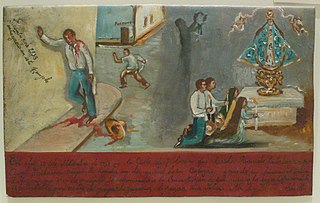
Votive paintings in Mexico go by several names in Spanish such as “ex voto,” “retablo” or “lámina,” which refer to their purpose, place often found, or material from which they are traditionally made respectively. The painting of religious images to give thanks for a miracle or favour received in this country is part of a long tradition of such in the world. The offering of such items has more immediate precedence in both the Mesoamerican and European lines of Mexican culture, but the form that most votive paintings take from the colonial period to the present was brought to Mexico by the Spanish. As in Europe, votive paintings began as static images of saints or other religious figures which were then donated to a church. Later, narrative images, telling the personal story of a miracle or favor received appeared. These paintings were first produced by the wealthy and often on canvas; however, as sheets of tin became affordable, lower classes began to have these painted on this medium. The narrative version on metal sheets is now the traditional and representative form of votive paintings, although modern works can be executed on paper or any other medium.

Various types of visual arts developed in the geographical area now known as Mexico. The development of these arts roughly follows the history of Mexico, divided into the prehispanic Mesoamerican era, the colonial period, with the period after Mexican War of Independence, the development Mexican national identity through art in the nineteenth century, and the florescence of modern Mexican art after the Mexican Revolution (1910-1920).

Deyanira África González Melo is a Mexican sculptor who generally works in ceramics, depicting elements of the human form, especially the torso, generally with mutilations and other disturbing elements to dispute the otherwise traditional and sensual depictions of the human body. She has exhibited her work since studying at the Escuela Nacional de Artes Plásticas (ENAP) in Mexico as well as in Europe and the Caribbean. Her work has received recognition in Mexico and abroad, and is a member of the Salón de la Plástica Mexicana.
Leonel Maciel is a Mexican artist, member of the Salón de la Plástica Mexicana, from the coast of the state of Guerrero. Although from a rural area and farming family, he studied art at the Escuela Nacional de Pintura, Escultura y Grabado "La Esmeralda" and has traveled extensively in Europe and Asia, which has influenced his work. His art has changed styles from generally contains multiple elements and saturated colors.
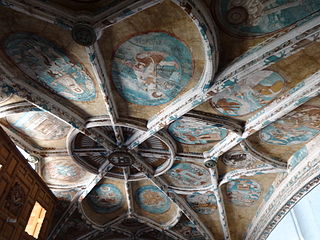
Juan Gerson was a high status indigenous Nahua painter, named after the French theologian Jean Gerson, working in Tecamachalco, Puebla. Not until 1962 when a group of Mexican scholars found documentation to his high status indigenous heritage was Gerson identity revealed. It was previously thought he was Flemish, trained in Italy, working from entirely within the European tradition before coming to colonial Mexico. Art historians Carolyn Dean and Dana Leibsohn consider Gerson's case of misrecognition as "reveal[ing] once again our refusal to recognize the indigene unless his or her work is visibly pre-Hispanic. Further, the revisions of scholarship that follow the discovery of these artists' genetic make-up involve a literal re-seeing of their work." Mexican art historian Francisco Pérez Salazar considers his work "mediocre and defective."

Mendicant monasteries in Mexico were one of the architectural solutions devised by the friars of the mendicant orders in the 16th century to the evangelization in the New Spain. The religious function of these buildings was thought for an enormous number of Amerindian indigenous people to evangelize although soon, due to the policy of reduction, the whole became the social center of the pueblos de indios, transmitting to them the civil modes of the West, Castilian, various arts and crafts, health, and even funeral services.
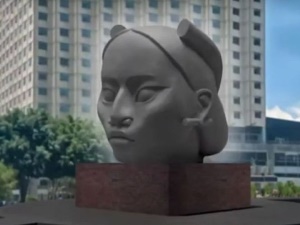
Tlalli was a proposed sculpture of a large indigenous woman's head by contemporary artist Pedro Reyes. It was proposed to replace the Monument to Christopher Columbus along Mexico City's Paseo de la Reforma.
